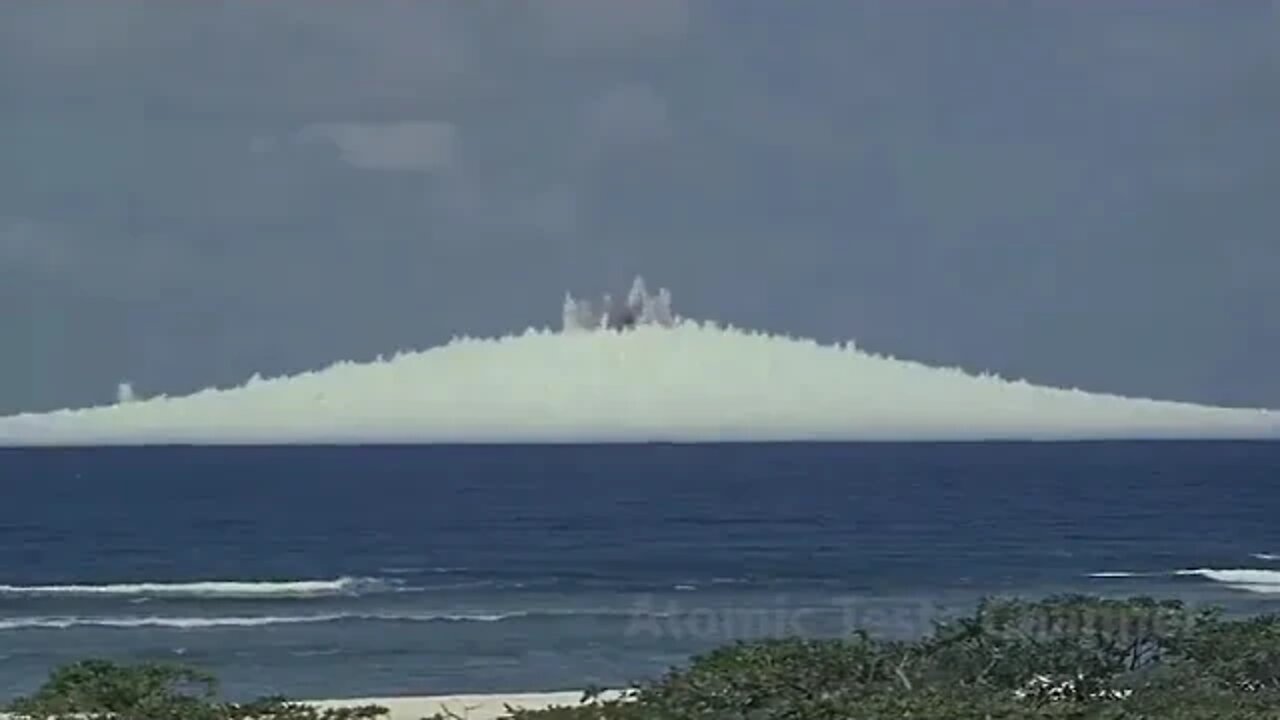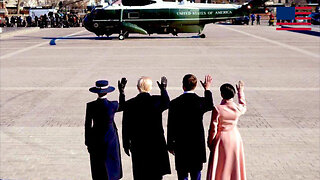Premium Only Content

nuclear bomb detonated underwater Marshall Islands (1958)
nuclear bomb being detonated underwater 1958
A newly unearthed video from the early days of the Atomic Age shows the raw power of nuclear weapons—even if that power is relatively tame by modern standards.
In the clip, a Mark 7 nuclear gravity bomb explodes deep underwater, but creates a column of water vapor more than half a mile high:
The test (code name: Wahoo), took place on May 16, 1958. The detonation point was the open ocean near Enewetak Atoll in the Marshall Islands. According to the Nuclear Weapons Archive, the Wahoo device was detonated at a depth of 500 feet in 3,200 feet of water.
The Mark 7, which debuted in 1952, was a tactical nuclear weapon designed to be carried by fighters (the F-84 Thunderjet, F-100 Super Sabre, and F-101 Voodoo) and bombers (the B-57) and dropped on enemy ground forces, according to the National Museum of the U.S. Air Force. Navy aircraft like the A-1 Skyraider, A-3 Skywarrior, F2H Banshee, and F3H-2N Demon, and FJ-4B Fury could also carry the Mark 7.
The bomb had an explosive yield of 9 kilotons, or about two-thirds the yield of the bomb dropped on Hiroshima, and yet was considerably smaller and more compact than the “Little Boy” bomb.
Within a second of detonation, a spray dome was created that reached a height of 840 feet (260 m) after seven seconds. The overall shape of the spray dome resembled a cone with 45 degree sloped sides. Plumes were seen breaking through the spray dome after six seconds in every direction. The vertical plume continued rising until 12 seconds after the blast while the lateral plumes traveled for 20 seconds before collapsing. The diameter of the spray dome was approximately 3,800 feet (1,200 m) at the 20 second mark.
The purpose of the test was apparently to determine the weapon’s effectiveness against surface ships, as well as a surfaced submarine. A number of target ships were moored nearby, including the retired destroyers USS Howorth, USS Fullam, and USS Killen, and the submarines USS Sterlet and Bonita.
According to Atomic Tests, the SS Michael Moran, a former merchant ship, “moored at 2,346 feet (715 meters) away was immobilized due to shock damage to its main and auxiliary equipment while also suffering minor hull damage.”
The Mark 7 bomb was quickly eclipsed by devices that were, pound for pound, exponentially more powerful. The B53 thermonuclear bomb, which debuted in 1961, had an explosive yield of 9 megatons and was the most powerful bomb to enter U.S. military service. (A Mark 7, by comparison, only had a yield of 9 kilotons, which means the B53 bomb was 1,000 times more powerful than the weapon in the video.)
The last B53 bomb was dismantled in 2011, leaving the B83 as the most powerful thermonuclear device in America’s deployed inventory. The B83 is “just” 1.3 megatons, or 1,300 kilotons.
The Limited Test Ban Treaty, ratified in 1963, prohibits testing nuclear weapons on land, at sea, or in space.
-
 2:09:53
2:09:53
Benny Johnson
5 hours ago🚨President Trump LIVE Right Now Making MASSIVE Announcement At White House News Conference
191K214 -
 2:04:10
2:04:10
Revenge of the Cis
5 hours agoEpisode 1433: Retribution
61.2K13 -
 1:42:50
1:42:50
The Criminal Connection Podcast
9 hours ago $0.30 earnedEddie Hearn talks JOSHUA vs FURY, Working With Frank Warren & The Truth About Turki Alalshikh!
19.2K1 -
 1:00:25
1:00:25
In The Litter Box w/ Jewels & Catturd
1 day agoGolden Age | In the Litter Box w/ Jewels & Catturd – Ep. 724 – 1/21/2025
112K55 -
 57:42
57:42
The Dan Bongino Show
12 hours agoHE'S BACK! (Ep. 2405) - 01/21/2025
1.28M2.03K -
 46:19
46:19
Candace Show Podcast
6 hours agoUH-OH! Elon’s Viral Salute Steals The Inauguration Show | Candace Ep 136
125K347 -
 8:05:01
8:05:01
hambinooo
10 hours agoNO COMMIE TUESDAY
85.3K3 -
 2:08:37
2:08:37
The Quartering
7 hours agoTrump Ends Online Censorship, Foreign Aid, Frees J6 Hostages & Much More In Day 1
125K44 -
 1:33:37
1:33:37
Russell Brand
9 hours agoBudget Cuts, Fires, and the Failures of Leadership – SF523
289K130 -
 1:57:42
1:57:42
The Charlie Kirk Show
8 hours agoAmerica's New Golden Age: Day 2 | Kelly, Kane | 1.21.2025
243K118